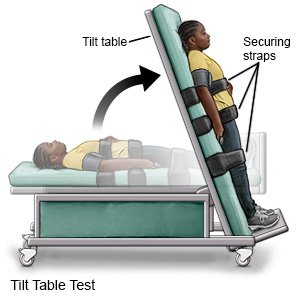Tilt Table Test
Medically reviewed by Drugs.com. Last updated on May 6, 2024.
What do I need to know about a tilt table test?
A tilt table test is a procedure used to find out why you have been fainting or feeling dizzy. Fainting may also be called syncope. You will lie on a table that tilts your body into different positions. The table provides a safe way to test your heart rate and blood pressure when you change positions. The tilt table test will help you and your healthcare provider recognize symptoms that occur before you faint. This will help you learn when to sit or lie down to prevent you from fainting.
How do I prepare for a tilt table test?
Your healthcare provider will tell you what medicines to take or not take on the day of your surgery. Do not eat or drink anything for 4 to 8 hours before the test. Ask your healthcare provider if you will be able to drive yourself home after the test. You may need to arrange for someone to drive you.
What will happen during a tilt table test?
You will need to stay on your back for the entire test. Your heart rate and blood pressure will be monitored to check for changes.
- You will lie on a soft table that has a foot support and straps. The straps will keep you from falling off when the table moves or if you pass out. The table will rotate your body between standing and lying positions. This will cause changes in your blood pressure and heart rate.
- You may be given medicine that causes your heart to beat faster and stronger. This helps confirm that your dizziness or fainting is caused by blood pressure or heart rate problems. The test may be repeated with and without the medicine.
 |
What will happen after a tilt table test?
You may have nausea, weakness, or a headache for up to 30 minutes after the test. Your heart rate and blood pressure will be monitored for up to 1 hour after the test. You will be able to go home when the healthcare provider knows you are okay. Have someone else drive you home if you fainted during the test.
What are the risks of a tilt table test?
You may feel dizzy, have an irregular or fast heartbeat, or low blood pressure during the test. Rarely, this test may cause you to faint. The medicine that is given during this test may cause you to have mild stomach cramping and a salty taste in your mouth. The medicine may also cause minor changes in your vision.
What do I need to know about my test results?
Your healthcare provider will discuss your test results with you. You may need more tests if your blood pressure dropped during the test and you felt dizzy or faint. You may also need to change the medicines you take. Depending on the cause of your drop in blood pressure, you may need other treatment.
Care Agreement
You have the right to help plan your care. Learn about your health condition and how it may be treated. Discuss treatment options with your healthcare providers to decide what care you want to receive. You always have the right to refuse treatment. The above information is an educational aid only. It is not intended as medical advice for individual conditions or treatments. Talk to your doctor, nurse or pharmacist before following any medical regimen to see if it is safe and effective for you.© Copyright Merative 2024 Information is for End User's use only and may not be sold, redistributed or otherwise used for commercial purposes.
Further information
Always consult your healthcare provider to ensure the information displayed on this page applies to your personal circumstances.
